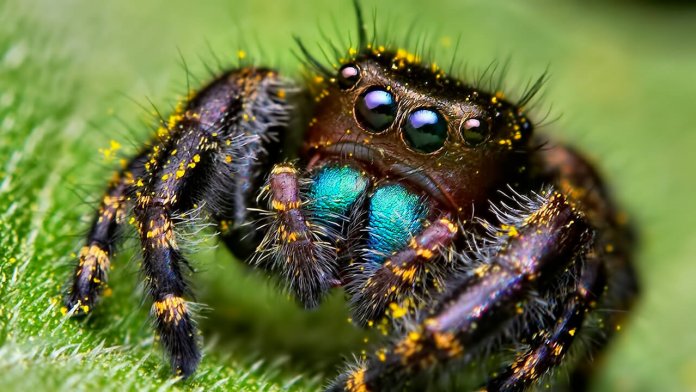The spider is one of the most terrifying creatures on Earth. Any person suffering from arachnophobia will confirm this to you. Perhaps you will say: what could be terrible in such a small creature? And I will answer you with a question to the question: "Which one is so small?" Look at the largest spider in the worldand find out where he lives so you can plan your vacation further away.
10. Wall tegenaria (Cerbalus Aravaensis) - body 3 cm, leg span 14 cm
 Where he lives: in the desert dunes of Wadi al-Arabs in southern Israel and Jordan.
Where he lives: in the desert dunes of Wadi al-Arabs in southern Israel and Jordan.
This is the smallest arachnid in our collection, and one of the largest spiders on Earth.
Dehydration and sunburn are not the only threats you face if you find yourself in the hot sand dunes of the Wadi al Araba Desert. After all, this is the home of the largest hunting spider in the Middle East. He creates his lair in the sand, and goes "on business" at night. Scientists do not believe that wall tegenaria is highly poisonous, but none of them tested this hypothesis.
9.Brazilian wandering spider (Phoneutria fera) - body 10 cm, leg span 7 cm
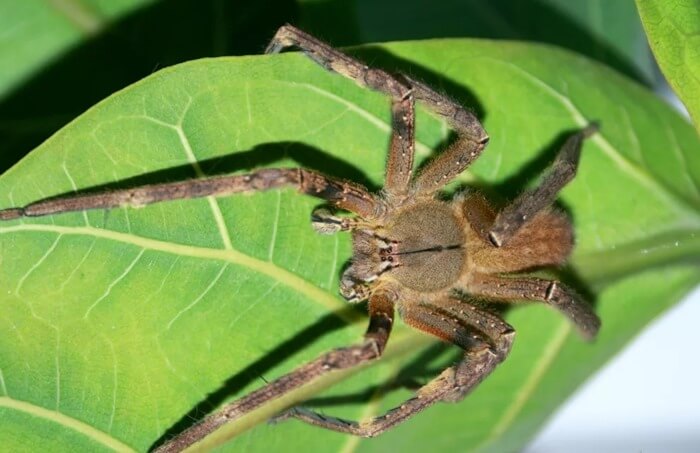 Where he lives: South and Central America.
Where he lives: South and Central America.
Not the biggest spider on the list, but the most dangerous one. This furry banana lover even made it into the 2010 Guinness Book of World Records as the most venomous spider in the world. Guinness does not have a category for the most aggressive spiders, otherwise the Brazilian spider would fall into it. In this regard, it is very close to the most venomous snake in the world, she is also not famous for meek character.
When there are no bananas nearby, the eight-legged Brazilian eats mice, lizards and large insects. To kill a 20-gram mouse, a spider needs to inject 6 micrograms of poison intravenously and 134 micrograms subcutaneously. For comparison, a black widow will need 110 mcg and 200 mcg of poison for the same purpose, respectively.
The poison of the Brazilian wandering spider is very dangerous, and can kill a person in two hours. It can also cause a four-hour, painful erection in men. So in the future, this dangerous arthropod may serve science as a treatment for erectile dysfunction.
8. Camel spider (Solfigae) - body 5-7 cm, leg span 12-15 cm
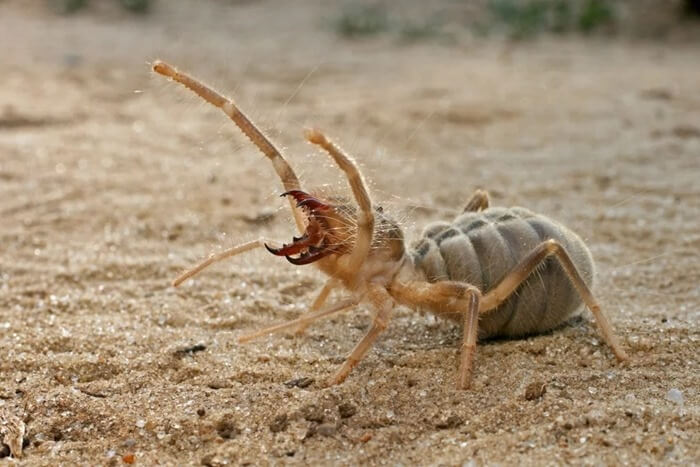
Where he lives: in any warm desert area. You are safe (from this spider) in Australia. He has never been seen in Antarctica, if that helps you.
Also known as the solpuga, this spider gets its informal name for eating camels for breakfast. Didn't believe it? And rightly so. He was nicknamed "camel" for the "humps" on his head. According to other information, a frightened spider jumps high enough and can grab with its powerful chelicera (jaws) what is above it. In the desert, this something often turns out to be the smell of a camel.
Salpuga's jaws are so strong that they can even pierce a human nail.In the video of the largest spiders in the world, the solpegs look the most menacing, especially when you look at their jaw from the side. The teeth and the cutting edge are clearly visible on it.
The good news is this spider is not venomous. The bad news is that if it bites you, rotting food debris can enter the wound, which can lead to severe inflammation.
7. Hercules Baboon Spider - body size from 7 to 9 cm, leg span up to 20 cm
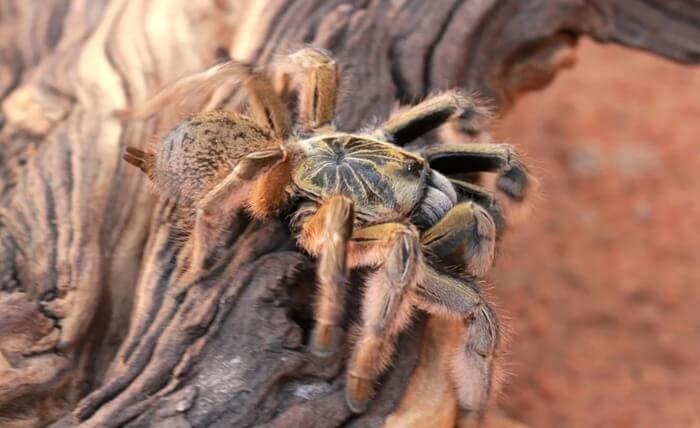 Where he lives: In African countries such as Niger, Benin, Ghana, Cameroon and Nigeria.
Where he lives: In African countries such as Niger, Benin, Ghana, Cameroon and Nigeria.
The only known specimen of the Herculean baboon was caught in Nigeria about a century ago and is in the Natural History Museum in London. It got its name from its habit of eating baboons (just kidding). In fact, this spider is named for the similarity between its legs and the baboon's toes. Since no one has seen this spider for a long time, there is an assumption that it disappeared from the face of the Earth. In a more optimistic version, he can lead life underground, away from human eyes.
A close relative of the Herculean baboon, the royal baboon spider (Pelinobius muticus) lives in East Africa, and another related subfamily, Harpactirinae, is famous for its aggressive and unpredictable behavior and strong venom.
6. Ornamental rajai tarantula (Poecilotheria rajaei) - 8 cm body, limb span up to 20 cm
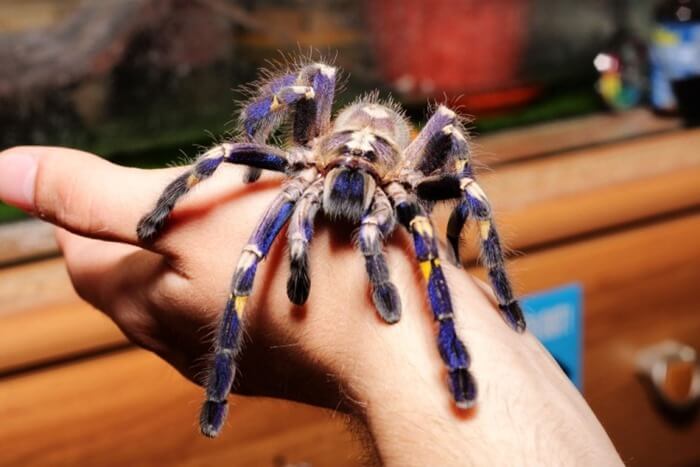 Where he lives: in old trees or in old buildings in Sri Lanka and India.
Where he lives: in old trees or in old buildings in Sri Lanka and India.
Tarantulas live not only in Central and South America. A huge tarantula the size of a human face has adapted to deforestation in Sri Lanka, and moved to abandoned buildings. He likes to eat birds, lizards, rodents and even snakes.
This species was discovered relatively recently, in 2009. And its name Poecilotheria rajaei got in honor of the police officer Michael Rajakumar Purajah, who guarded the scientists during their expedition.
5. Colombian giant tarantula (Megaphobema robustum) - body 8 cm, paws span up to 20 cm
 Where he lives: in the rainforests of Brazil and Colombia.
Where he lives: in the rainforests of Brazil and Colombia.
This member of the tarantula family feeds on mice, lizards and large insects, so you can use it to control pests. It is rarely brought to Russia, and any arachnophile collector dreams of getting a handsome Colombian.
This species has thorns on its hind legs, with which the spider attacks and fights off enemies. He is not aggressive towards a person, but he can bite on occasion. The poison in the Colombian giant tarantula is not fatal, but there is a risk of an allergic reaction. In short, this is not the most suitable pet.
4. Brazilian black tarantula (Grammostola anthracina) - body 16-18 cm, paws span 7-10 cm
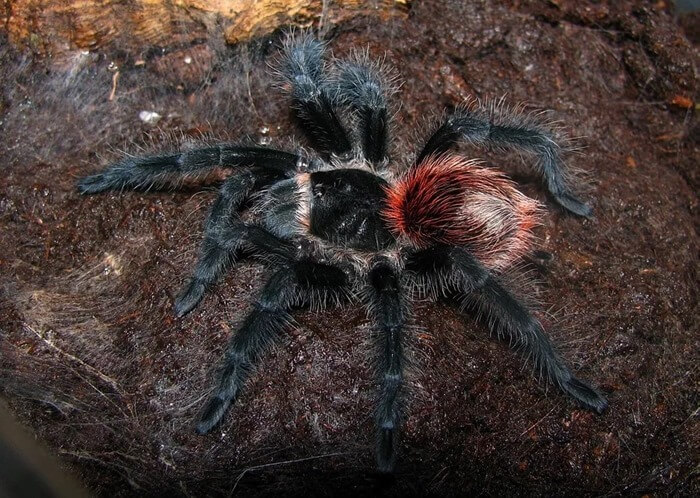 Where he lives: in Uruguay, Paraguay, Brazil and Argentina.
Where he lives: in Uruguay, Paraguay, Brazil and Argentina.
Don't forget to visit South America if you are looking for giant spiders. Grammostola anthracin is one of the species of tarantula spiders, which is very popular because of its beautiful black "fur" with a metallic sheen. He is unlikely to bite you if you remember to feed him cockroaches or crickets. However, the long hairs on the legs and torso of the Brazilian tarantula can cause irritation upon contact with human skin.
3. Horse spider (Lasiodora parahybana) - body 8-10 cm, paws span up to 25 cm
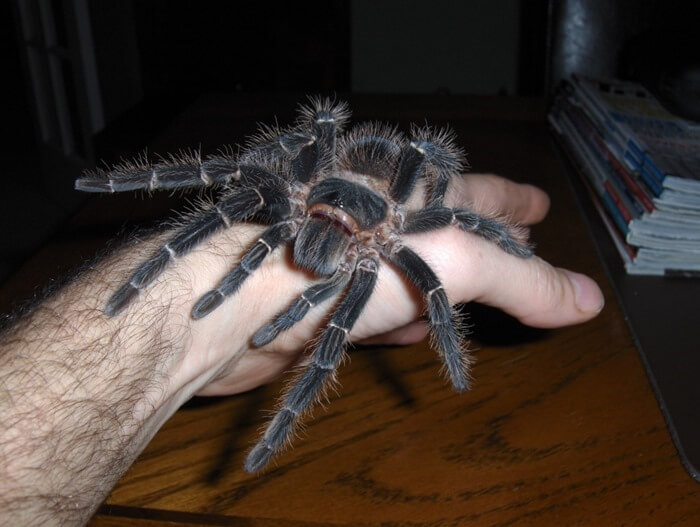 Where he lives: in the forests of Brazil. They are a popular pet, so you can see them in pet stores and possibly in a neighbor's apartment.
Where he lives: in the forests of Brazil. They are a popular pet, so you can see them in pet stores and possibly in a neighbor's apartment.
The third of the largest spiders in the world breeders easily in captivity and is considered docile. However, if provoked, a horse spider can bite, not too dangerous, but quite painful. Also, these animals have a "cute" habit when in danger of combing stinging hairs. Therefore, keep the spider away from your eyes.
2. Giant hunter spider (Heteropoda maxima) - body 4.6 cm, paws span from 25 to 30 cm
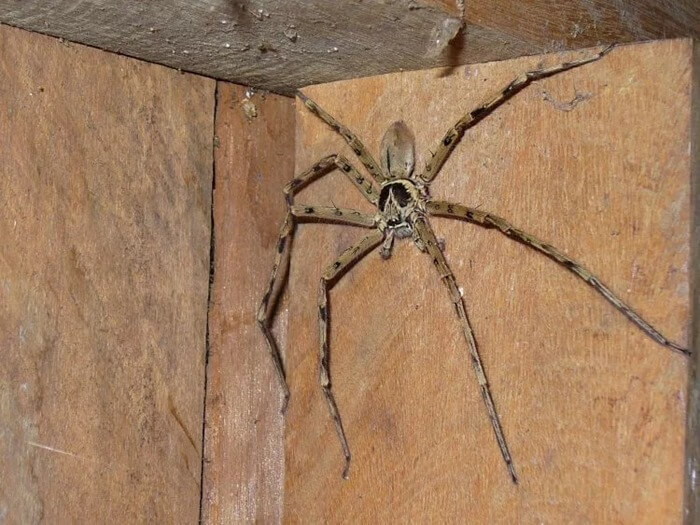 Where it lives: only in the caves of Laos, but huge hunter spiders like it live in all warm and temperate regions of the planet.
Where it lives: only in the caves of Laos, but huge hunter spiders like it live in all warm and temperate regions of the planet.
While the goliath tarantula (number one on the list) is considered the most massive spider on Earth, the giant hunter spider has longer legs. Their scope reaches from 25 to 30 centimeters.
These spiders are dangerous not only for their natural enemies, but also for humans. After their bite, hospitalization may be required.If you live in a warm climate, and hear a rhythmic ticking sound similar to the ticking of a quartz clock, know that a male Heteropoda maxima is nearby. And if you're not a female giant spider, you better run.
1. Goliath tarantula (Theraphosa blondi) - body 10.4 cm, paws span up to 28 cm
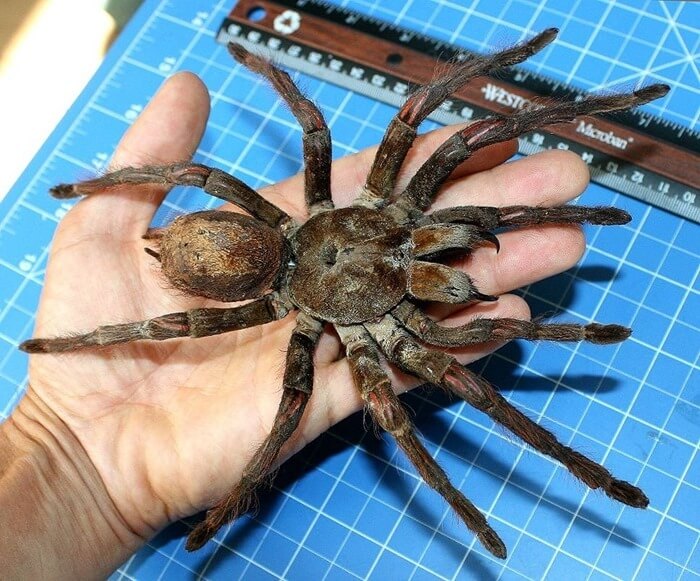 Where he lives: Burrows in the rainforests and swamps of northern South America.
Where he lives: Burrows in the rainforests and swamps of northern South America.
Here it is, the largest spider in the world. He looks intimidating in the photo, and for good reason. The goliath tarantula is a species of tarantula. Teraphosis blond can bite a person with its huge fangs (1-2 cm), and its poison is comparable in pain and general effect with the poison of a wasp.
The spiky hairs of this giant "furry" are a big threat, as they can remain on the skin and in the eyes of a person, causing itching and irritation for several days.
One of Theraphosa blondi was even lucky enough to get into the Guinness Book of Records as the largest representative of her species. The paws of this specimen, caught in Venezuela in 1965, was 28 centimeters.
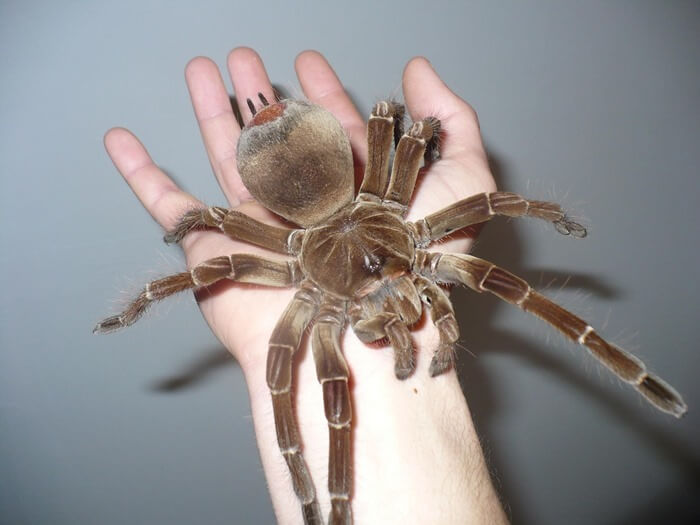 As the name suggests, this spider sometimes eats small birds such as hummingbirds. But he himself can turn from a hunter into a tasty prey. People who live in the habitat of goliath tarantulas catch and eat them (they taste like shrimp).
As the name suggests, this spider sometimes eats small birds such as hummingbirds. But he himself can turn from a hunter into a tasty prey. People who live in the habitat of goliath tarantulas catch and eat them (they taste like shrimp).
And finally, an interesting fact: Male spiders have specialized appendages that are used to create the sounds needed for protection and sexual communication. The largest spiders make sounds loud enough for humans to hear. So if you hear a strange sound in the night, there may be a sexually anxious spider nearby.

